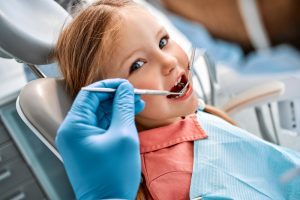Start at The Smile’s Foundation With Two-Stage Orthodontic Treatment
 Help your child create great oral health from the very foundation of their smile. At Jacklyn Kurth Orthodontics, Dr. Jacklyn Kurth and Dr. Laura Chew use two-stage orthodontic treatment to give kids a head-start on their orthodontic treatment. Beginning with a focus on foundational tooth and jawbone structure, two-stage orthodontics with our Belmont and Foster City, CA, orthodontists create a better oral environment for easier orthodontic treatment for kids.
Help your child create great oral health from the very foundation of their smile. At Jacklyn Kurth Orthodontics, Dr. Jacklyn Kurth and Dr. Laura Chew use two-stage orthodontic treatment to give kids a head-start on their orthodontic treatment. Beginning with a focus on foundational tooth and jawbone structure, two-stage orthodontics with our Belmont and Foster City, CA, orthodontists create a better oral environment for easier orthodontic treatment for kids.
Call (650) 592-4850 for our Belmont office or (650) 525-9440 for our Foster City office today to schedule your child’s free orthodontic consultation.
What Is Two-Stage Orthodontic Treatment?
Two-stage orthodontic treatment is a customized orthodontic process that spaces out treatment over an initial and secondary phase:
The Initial Phase
- Focuses on foundational issues like preparing for incoming permanent teeth, expanding constricted palates, guiding eruption, and aligning dental arches
- Makes structural corrections to jaw growth and bite before all permanent teeth fully erupt
- Aims to align much of the full smile while allowing further facial and dental development
The Secondary Phase
- Fine-tunes alignment, levels arches, straightens rotation, and finishes more targeted bite repairs
- It occurs once all permanent teeth have fully erupted
- Applies light orthodontic pressure to complete corrections
Benefits of Two-Stage Orthodontic Treatment
Two-stage orthodontics offers many perks compared to standard single-phase treatment:
- Greater Comfort: Shorter appointment times spaced further apart feel more manageable. Less stress promotes faster, healthier healing.
- Better Longevity: Dividing care into two strategic segments optimizes stability, minimizing relapse risks. Specialized retention between stages enhances the longevity of initially straightened teeth.
- Ideal Timing: Earlier intervention makes foundational changes before all permanent teeth fully erupt, allowing customization around unpredictable growth changes. Correcting major structural issues in the first phase prevents more aggressive repairs later.
- Reduced Invasiveness: Separating alignment into two phases decreases how intensively certain mechanisms need to move teeth and jaws, optimizing facial development and supporting dental root health.
- Personalized Care: Adjusting mechanics and timing mid-treatment based on each patient’s response allows Drs. Kurth and Chew to personalize care, promoting the best outcome.
- Shortened Treatment Length: Though occurring in two segments, using lighter forces spaced further apart, total treatment can finish faster than attempting all corrections using heavier pressure all at once.
Candidates for Two Stage Orthodontic Treatment

- Early Treatment: Children aged seven to 10 with severe overcrowding benefit from expanding their palates sooner. This prevents more extensive tooth extractions and development issues later. Early correction in the first stage makes alignment easier once all permanent teeth fully erupt.
- Complex Cases Requiring Specialized Retention: Teenagers and adults with deep bites, anterior crossbites, or skeletal discrepancies like underbites and overjet often need strategic staging to maximize stability after repositioning bite segments and profiles with veneers, jaw surgery, or restorative fillings.
- Health Complications: Patients who struggle with tooth grinding, clenching, or oral health vulnerabilities like gum recession heal and recover better with shorter, gentler treatment protocols.
- Minimally Invasive Corrections: People who want straighter teeth without wearing braces for multiple years prefer avoiding extracting healthy teeth or more aggressive traditional orthodontic mechanics when possible.
The Two-Stage Orthodontic Treatment Process at Jacklyn Kurth Orthodontics
During your initial consultation, Drs. Jacklyn Kurth and Laura Chew will thoroughly evaluate your child’s oral health, bite alignment, jaw growth, tooth eruption stages, and facial profile to decide whether two-stage orthodontics is right for them.
Phase One Aligns the Framework
The initial phase primarily addresses foundational bite and spacing problems by expanding palates, uprighting molars, guiding erupting teeth, preventing overcrowding, and aligning gradual irregularities as the overall arch takes form.
Treatment time ranges from six to 18 months, with adjustments every four to six weeks using comfortable braces, clear aligners, space maintainers, and interceptive expanders as needed.
A Brief Retention Period Stabilizes Progress
To solidify the framework alignment, Drs. Kurth and Chew design custom fixed or removable retainers worn for six to 12 months before moving to Phase Two. Retaining stabilized corrections minimizes the re-alignment needed later and prevents spacing relapse from new growth or continuing eruption.
Phase Two Perfects the Smile
Once all permanent teeth erupt, the second treatment phase fine-tunes alignment, straightens tooth rotation, levels arches, and finishes targeted bite repairs using light orthodontic pressure. We’ll schedule adjustment visits every eight to 12 weeks. Finishing this final alignment phase takes six to 18 months, depending on individual needs.
Orthodontic Treatment Retention
After completing two-stage orthodontics, Drs. Kurth and Chew craft customized retainers for ongoing stability. Retainers protect your teeth from shifting and settling.
Frequently Asked Questions
At what ages does two-phase treatment happen?
The first phase often occurs between ages eight to 11 when many permanent teeth emerge, but it can begin as early as six. Phase two follows between ages 12 to 16.
Do I have to get braces again in phase two?
Braces often get used in both phases, but new styles can shorten treatment times. Clear aligners may also help finish alignment without braces. Your orthodontist will determine what works best in each phase.
Why does an early phase one help?
Starting the first phase while jaw growth continues allows guidance of permanent teeth eruption into more favorable positions. It also permits early correction of developing problems to circumvent more invasive procedures later.
What kinds of retainers hold teeth in position after treatment?
Custom removable and fixed retainers can help keep newly aligned teeth stable after two-phase therapy. Wearing these appliances as directed prevents tooth movement.
Help Your Child Create A Stunning Smile
Two-stage orthodontic treatment offers immense benefits for complex cases. By separating your treatment into strategic early intervention and final alignment, Dr. Jacklyn Kurth and Dr. Laura Chew can unlock your best possible smile.
Contact Jacklyn Kurth Orthodontics for your child’s free orthodontic consultation at our Foster City and Belmont offices. Call (650) 525-9440 for our Foster City office or (650) 592-4850 for our Belmont office.